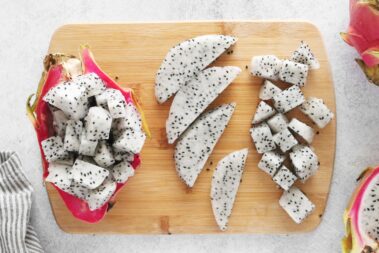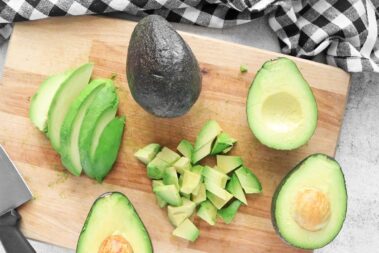The bright red juices of the pomegranate fruit are loaded with antioxidants that can help the body fight inflammation, cancer, and more. But getting at all that nutritious goodness can be a challenge given the pomegranate’s thick, leathery rind. Not to mention the messy, clinging white pith.
Below, we’ll give you our inside scoop on how to cut a pomegranate to avoid the mess and the hassle. We’ll also tell you how to eat a pomegranate, whether you prefer it fresh, baked, or otherwise.
Table of Contents
What Is a Pomegranate?
In medieval Latin, the word pomegranate means “apple seeded,” which isn’t the worst description of this odd fruit. The shape is somewhat like an apple, although an overgrown rose hip would be far more apt. And it certainly has its fair share of seeds.
It’s these seeds, which are small, crunchy, and surrounded by a juice-filled endocarp, that make up the edible part of the pomegranate.
This fruit is native to Persia, including modern-day Iran and Northern India. The trees, which are technically large, deciduous bushes, were spread throughout the Middle East, Mediterranean, and India, by traders thousands of years ago.
Today, pomegranates are grown in mild, dry temperate climates across the globe. In America, they thrive in California, Arizona, and Texas.
In the northern hemisphere, pomegranates are harvested in the fall, from about September to February. This makes them the perfect fruit to accent harvest holidays in October, Thanksgiving in November, and all your holiday festivities in December.
Health Benefits of Pomegranate
If it weren’t for the amazing health benefits of pomegranates, modern humans probably wouldn’t eat nearly as many of them considering the work it takes to get the seeds out. But these fruits truly are worth the effort.
The arils, or seeds of pomegranates, are loaded with vitamin C and fiber. And the nutrient-rich juice that enshrouds the seeds is brimming with antioxidants that help fight inflammation in the body.
These antioxidants include anthocyanins, punicalagins, and hydrolyzable tannins. By neutralizing destructive free radicals, these compounds protect the body against disease and have a powerful anti-inflammatory effect. (1)
Pomegranates are also a good source of potassium, magnesium, and phosphorus. Some studies link pomegranate juice and seeds with lower rates of cancer and better heart health. (2)
How to Cut and Eat a Pomegranate
To enjoy all the goodness pomegranates have to offer, you first need to figure out how to battle that leathery skin to get at the juicy arils inside. This can be a messy project, but only if you don’t know the trick to tackling these odd fruits.
To harvest the red, juice-covered seeds of a pomegranate without dying your hands and kitchen red, simply follow these steps:
- Cut the crown of the pomegranate, also known as the blossom end, off. Be sure to use a large, sharp knife and a sturdy cutting board. Take about ¼ inch off to get through the white membrane, revealing the first layer of ruby-red seeds.
- Use a paring knife (or sturdy tomato knife) to score the peel from the cut end to the stem along the ridges. Make sure your slices are deep enough to penetrate the leathery skin but not deep enough to cut the fruit open.
- Repeat this process until you have scored the fruit four times to create equal quarters. For a large fruit, you may need to slice it into five or six sections.
- Now, place the pomegranate into a bowl of water with the crown side down. Use a large bowl and cold water for best results. Hold the fruit under the water until it fills up and sinks.
- While still submerged, use your hands to rip the fruit open along the seams you created.
- With the pomegranate sections still in the water, separate the seeds from the pith using your fingers. The seeds will sink to the bottom of the bowl while the white pith pieces float to the top.
- Discard the rind and pith.
- Using a sieve or fine colander, strain the water from the seeds.
You can now enjoy your fresh pomegranate seeds! These are excellent as a snack all on their own or they can be juiced in your home juicer.
Pomegranate seeds make a wonderful topper for baked goods, yogurt, ice cream, and salads. They can also be used in a number of sweet desserts and savory dishes (see below).
Any leftover pomegranate arils can be stored in an airtight container in the fridge for up to five days. You can also freeze pomegranate seeds for up to six months. Pomegranate juice should be kept chilled and consumed within a day to preserve nutrients.
Our Favorite Pomegranate Recipes
Once you get the juicy little seeds out of your pomegranate, you aren’t going to want to waste a single one. Here are some of our favorite recipes that include pomegranate juice or arils so you never run out of ways to use this valuable fruit.
- Easy Dragon Fruit Salad – Delicious and gorgeous dragon fruit is the star of this show, but pomegranate seeds add a much-needed pop of yummy tartness.
- Pomegranate Chocolates – These bite-sized treats are exactly what you need right now.
- Pomegranate Molasses – This thick syrup makes the perfect substitute for maple syrup or honey on your favorite breakfast foods. It has an intense flavor and gorgeous color to transform your mornings.
- Fall Harvest Salad with Maple Vinaigrette – This savory sweet autumn salad calls for cranberries to add that tart-sweetness, but it’s even better with juicy pomegranate.
- Sweet Potato Pomegranate Salad – This unique salad combines the earthy sweetness of sweet potatoes with the tongue-tingling sweetness of ripe pomegranates.
- Pomegranate Smoothie – This nutritious morning smoothie looks as great as it tastes.
- No-Bake Chocolate Pomegranate Tart – A rich, delectable raw chocolate tart that’s gluten-free and vegan? Yes, please!
- Overnight Oats with Pomegranate and Roasted Almonds – This oatmeal is nutritious, easy to make, and delicious.








